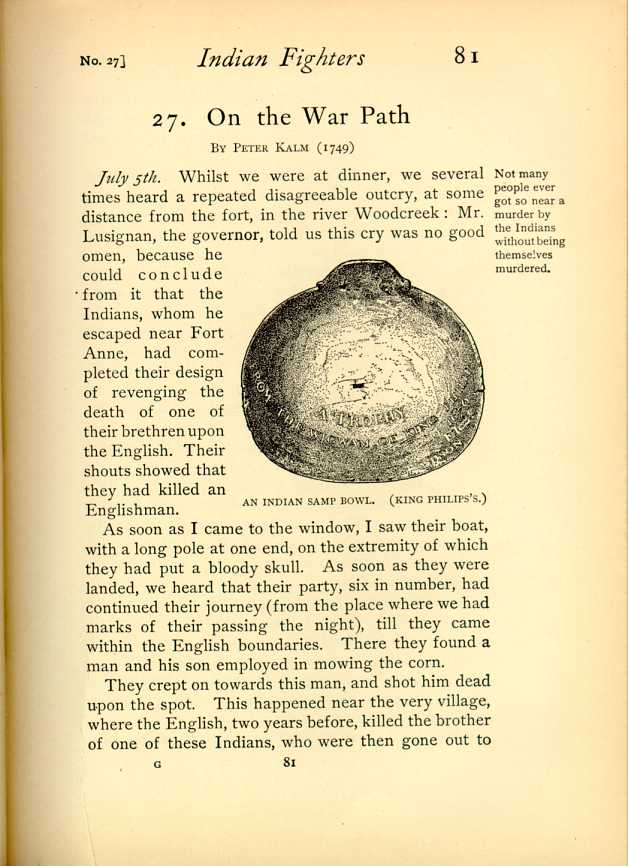| Camps and Firesides of the Revolution | ||
27. On the War Path
BY PETER KALM ( 1749)
July5th. Whilst we were at dinner, we several times heard a repeated disagreeable outcry, at some distance from the fort, in the river Woodcreek: Mr. Lusignan, the governor, told us this cry was no good omen, because he could conclude from it that the Indians, whom he escaped near Fort Anne, had completed their design of revenging the death of one of their brethren upon the English. Their shouts showed that they had killed an Englishman.[73]
As soon as I came to the window, I saw their boat, with a long pole at one end, on the extremity of which they had put a bloody skull. As soon as they were landed, we heard that their party, six in number, had continued their journey (from the place where we had marks of their passing the night), till they came within the English boundaries. There they found a man and his son employed in mowing the corn.
They crept on towards this man, and shot him dead upon the spot. This happened near the very village, where the English, two years before, killed the brother of one of these Indians, who were then gone out to
As soon as they came within a mile of Fort St. Frederic, they put the skull on a pole, in the fore part of the boat, and shouted as a sign of their success. They were dressed in shirts as usual, but some of them had put on the dead man's clothes, one his coat, the other his breeches, another his hat. Their faces were painted with vermillion, with which their shirts were marked across the shoulders.
Most of them had great rings in their ears, which seemed to be a great inconvenience to them, as they were obliged to hold them when they leaped, or did anything which required a violent motion. Some of them had girdles of the skins of rattlesnakes, with the rattles on them. The son of the murdered man had nothing but his shirt, breeches and cap, and the Indians had marked his shoulders with red.
When they got on shore, they took hold of the pole on which the skull was put, and danced and sung at the same time. Their view in taking the boy, was to carry him to their habitations, to educate him instead of their dead brother, and afterwards to marry him to one of their relations.
Notwithstanding they had perpetrated this act of violence in time of peace, contrary to the command of the governor in Montreal, and to the advice of the governor of St. Frederic, yet the latter could not at present deny them provisions, and whatever they wanted for their journey, because he did not think it advisable to exasperate them. When they came to Montreal, the governor called
| Camps and Firesides of the Revolution | ||
